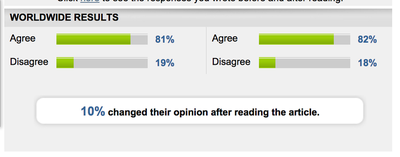Please 2x my math, aka, is my 4th grader's brain being scrambled by @Achieve3000?
This is from my 4th grader’s online homework assignment (the achieve3000.com assignment on St. Augustine History, for those of you in Gainesville). For these assignments they answer the same question before and after completing a reading and homework assignment. At the end they give you the results shown in the picture below:
[caption id=“attachment_8537” align=“aligncenter” width=“1021”]

My response when I saw this was: “huh”?
- One explanation is they meant “10% of the total student pool changed their mind”, e.g., 10 students changed their mind - some going from the “agree” to the “disagree” column and some going from “disagree” to “agree” column, with a net gain one one student in “agree”. But that’s not possible, because if you assume:
X = kids who voted “agree” in round one who voted “disagree” in round two &
Y = kids who voted “disagree” in round one and voted “agree” in round two
then you can set this up as a system of two equations with two unknowns:
81-X+Y = 82
19-Y+X = 18
that you can solve for (and only for) X = 0 and Y = 1. So only 1% of the sample could have possibly moved. This makes sense logically - there is only one combination of the sum of the numbers from 0-10 that sum to ten but have a difference of one are 0 and 1.
-
They could have meant “there was a 10% increase in the number of kids that agree” But that’s obviously not true because 10% of 81 is 8.1. 89.1 != 82.
-
The only possible explanations I can imagine is that they actually meant “there was a 10% decrease in the number of kids that disagree”. but even that is a mess because But 19->18 can be interpreted two ways: 1% of the total sample moved (which is correct but not 10%) or 10% of the kids in the “disagree” column changed their mind. 10% of 19 is 1.8. If this is the explanation, it only works if they round down the fraction of a kid such that: 19-1.8 = 19 - ~1 = 18.
If this is indeed their logic, this is insanely lame. “10% of the students changed their opinion” means “10% of the total number of students taking the before/after poll”. They should have said “approximately 10% of the students that disagreed the first time changed their mind the second time”.
We are doomed as a nation.